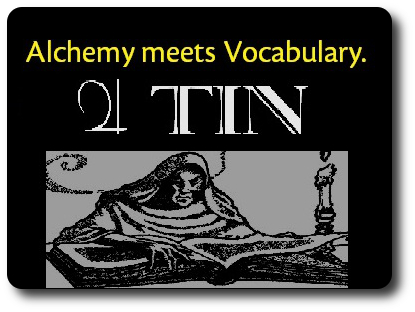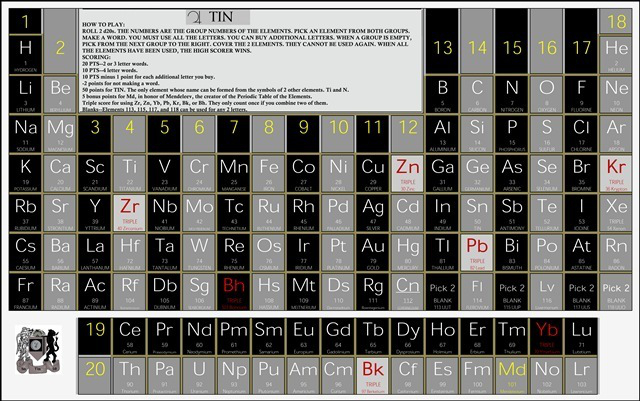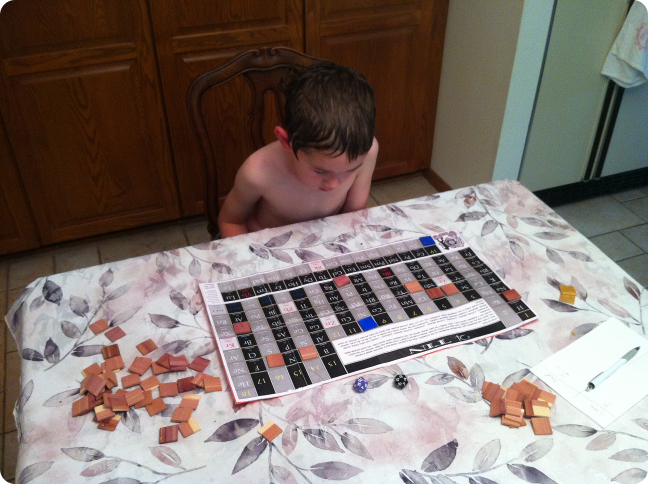Please Take Note: This is a review of the game’s final prototype. The art, game bits, and the rules discussed are all subject to change. The game is being reviewed on the components and the rules provided with the understanding that “what you see is not what you might get” when the game is published. If you like what you read and want to learn more, we encourage you to visit the Kickstarter project page to back it and get yourself a copy! Now that we have all that disclaimer junk out of the way, on with the review!

The Basics:
- For ages 12 and up
- For 1 to 4 players
- About 45 minutes to complete
Geek Skills:
- Active Listening & Communication
- Counting & Math
- Reading
Learning Curve:
- Child – Easy
- Adult – Easy
Theme & Narrative:
- None
Endorsements:
- Gamer Geek rejected!
- Parent Geek approved!
- Child Geek rejected!
Overview
What do you get when you combine chemical elements with word play? No, not the answer to the ultimate question of life, the universe, and everything (that’s “42”, silly). What you do get is a unique word game that will challenge players to make the shortest words as possible using the symbols (abbreviations) of the elements. In fact, the name of the game, TIN, is derived from the symbols of Titanium (Ti) and Nitrogen (N)! Understand the origins of the game’s name and you already know how to play.
TIN is comprised of a periodic table game board, 2 twenty-sided dice, and 120 wooden tiles (8 of which are in 4 different colors, 2 per player). Not included in the game, and necessary to play, is a pen or pencil and a piece of paper to keep score. Since this game has not yet been officially published, we will not comment on the quality of the components other than to report that the final production release of the periodic table game board will be made from a weighted edge vinyl. A sample of the material was provided and we found it to be very durable (not to mention vastly superior to the paper game board used for this review).
Game Set Up
To set up the game, give each player 2 colored tiles. Remove any unused colored tiles for the duration of the game. The non-colored tiles are placed in a pile close enough for all players to pick from.
Determine who the first player is, write down the names of the players on a piece of paper, and get ready to play!
Playing with the Elements
On a player’s turn, they will roll the 2 twenty-sided dice. Each die value will correspond to one of the 18 columns and 2 of the bottom rows on the periodic table game board (see following image). The player places their colored tiles on the numbered space beside the row or column that matches. These are used as markers and the player can use any element not already used in the column or row covered by a tile. If the column or row is unavailable (all the symbols are covered up from previous plays), the player places their colored tile on the next highest column or row that has free symbols.
Note: the rules are unclear on what to do if the player rolls the same value on both dice. We opted to simply re-roll one of the dice and the game played smoothly.
OK, that was the easy part! Now for the hard part…

The symbols of the elements on the periodic table provide the letters – the players have to provide the mind and creativity
The player now attempts to make a word using one symbol from the each of the columns or rows they rolled. Proper nouns and abbreviations are not allowed. This is all kinds of not easy and made even more difficult by the player losing points the longer the word is! Players can buy letters to create words, but this will reduce the total points earned.
For example, let’s say the player selected “Ac” (Actinium) from column 3 and “B” (Boron) from column 13. Any which way you flip them, “acb” and “bac” are not words that fit the rules. The player must then buy a letter, in this case a “K”, to form the word “back”.
Once a player does make a word, they take 2 of the non-colored tiles and cover the symbols they used, making them unavailable for the rest of the game. The points are counted for the word and recorded. The player then removes their colored tiles and passes the twenty-sided die to the next player.
If playing the game solo, simply rinse and repeat until the game ends.
Counting Points
Points are based on how many letters are in the word.
- 20 points for a 2-letter word
- 15 points for a 3-letter word
- 10 points for a 4-letter word
If the player is ever unable to create a word, they automatically lose 2 points.
Using our previous word example, “back” would be worth 10 points. A 5-letter word would be worth 9 points, a 6-letter word would be worth 8 points, and so on.
Like Scrabble, the periodic table game board has special spaces that will multiply the number of points earned if used in a word and spaces that act as “wilds” by allowing the player to select any 2 letters they wish.
If any player is able to create the word “tin”, they are awarded 50 points.
Winning the Game
The game ends once all the element symbols have been covered by a tile. All the points are now added or subtracted for each participant. The player with the most points wins the game! If playing solo, keep track of your score and try to beat it the next time you play.
To learn more about TIN, see the Kickstarter project.
Prediction
Interesting! The game is very simple in its execution and grows steadily more difficult as the game progresses. Creating words from random letters is nothing new, but I have yet to play a game where the periodic table is the board on which you play.
As far as my little geeks go, my 4-year-old is out of luck on this one. My 7-year-old, however, should be able to play the game. At least, initially. The steady reduction of available letters will make it more and more difficult for him to create words that will score big points. My concern is not that he will be unable to make a word (you can buy missing letters), but the lack of points and a feeling of being uncompetitive.
When I pitched the game to my little geek, he had no idea what the periodic table was and he first wanted to know all about it. I made a mental note to determine what exactly they were teaching my son in school and went about explaining the significance of the game board. This fascinated him and he spent a few minutes finding all the elements he knew about (gold and sodium, for example). He then became concerned that this was an “educational game” and became less interested.
I assured him that the game would be challenging but was not a science game. There is zero science, actually, which is funny when we consider the game’s board is one of the most important tools to chemists. Kind of like giving a player a box full of tools and telling them they won’t be used to build anything. It was with little surprise, then, that my little geek was highly doubtful of my claim.
When explained the game, he felt better about it. There are only a handful of rules and the game play is very straight forward. I gave him several examples of how to spell words and kept emphasising that “smaller was better”. I needed to make certain that he understood that this was not a word game that required the players to spell long words that were difficult to pronounce. Simple 3 to 4-letter words were the target. This greatly pleased him and we were ready to play within 5 minutes.
While I reset the game board, I asked him what he thought of the game so far.
“I was really worried there for a bit that I was going to have to know all about chemistry, but this is just a word game. I can play those!” ~ Liam (age 7)
Good! Let’s see if we can ride that level of enthusiasm and confidence all the way to the end of the game!
Final Word
TIN proved to be too much for my little geek. He was able to create words for about the first 10 rounds, but with the steady reduction of symbols available, he became more and more challenged. Even I had a difficult time creating words just using the symbols! And while the steady increase in difficulty makes a game more interesting, this served to be the turning point in the game for my little geek. He became frustrated and started to lose points left and right. Eventually, he was just saying he couldn’t make a word and took the negative points. This slowly eroded the points he had won and left him with a negative balance at the end of the game. When I asked him how he liked TIN, the painful look on his face told me all I needed to know. Additional game plays (3 in total) did not change his opinion. As a result, we cannot suggest this game to little geeks any younger than the suggested minimum age as noted by the designer/publisher.
Parent Geeks had a wonderful time with the game! Non-gamers and word geeks really enjoyed themselves and the games became rather intense! As the difficulty curve slowly grew, the players kept asking for the scores to be read out-loud so they could determine how many negative points they could take to remain competitive. It was a real surprise (and joy) to see the non-gamers get strangely aggressive with their game play.
Gamer Geeks didn’t care for the game. They acknowledged that TIN had a unique game design, but the game (according to them) was little more than picking low hanging fruit to collect as many points as possible and then just attempting to outlast the other players. A few Gamer Geeks, who were also word geeks, enjoyed TIN and suggested it was vastly superior to Scrabble.

My little geek looks over his symbol choices and thinks of a word to create
Gamer Geeks, there isn’t much for you here unless you enjoy word and language games. The game is challenging and even the most elitist of Gamer Geeks will be hard-pressed to score big points and win the game. Players with large vocabularies will tend to do better, but the random letters provided and the ability to buy new letters will keep anyone in the game. Perhaps the biggest selling point for the Gamer Geeks was the challenge, but the game ultimately failed to please due to its rather limited play and lack of any strategy or tactics.
Parent Geeks, this is an excellent family word game that doubles up as a chemistry lesson! The game is easy to teach and easy to play, but quickly becomes challenging. Non-gamers greatly enjoyed it and individuals who naturally enjoy word games loved every minute of it. None of our testers were scientist or chemists, however, so we can only speculate on the cool factor of using a periodic table as a game board. Still, every parent who played the game enjoyed it, chemist or not.
Child Geeks, you will need a large vocabulary and be creative to win this game. You must also be very aware of your points to know how best to manage your final score for victory. Do expect to take negative points in order to move forward and never be afraid to buy letters to make simple words. This is not a game that requires you to create large words, but you will be challenged. It is always better to score some points rather than none. Take your time, play with the letters, and you’ll get there!
TIN, was an interesting game to play and to teach. The difficulty curve is not terribly sharp and the learning curve is almost non-existent. If is very intuitive to play and steadily grows more challenging as less and less symbols are made available. As the game continues, players will score fewer and fewer points, meaning all those big scores in the beginning of the game start to be reduced quickly. This allowed even the slowest of players to eventually catch up with the pack and stay competitive.
Low scores and growing difficulty aside, the game is very casual and open to allowing players to create words with ease. In fact, there is never going to be a situation where a player cannot make a word if they add enough letters. A player who is paying attention, however, will soon realize there is a point of diminishing returns and will simply take the -2 points for their turn. One winning strategy by a player was to always select the two elements with the smallest number of letters and then add the necessary letters to make them a word. They never scored big, but they always scored positive points. This player also utilized the triple word score brilliantly and won the game with little issue.
TIN is a word game like so many others, but including the periodic table as the game board and as a letter randomizer makes it unique among its brethren. Add in the scoring mechanism that rewards smaller words and you have a game that challenges and plays quickly without ever leaving the player mentally winded or bruised. Nevertheless, an excellent mental and language exercise. For the word game lovers of the world, TIN is sure to please. Chemists and Gamers unite!
This game was given to Father Geek as a review copy. Father Geek was not paid, bribed, wined, dined, or threatened in vain hopes of influencing this review. Such is the statuesque and legendary integrity of Father Geek.



